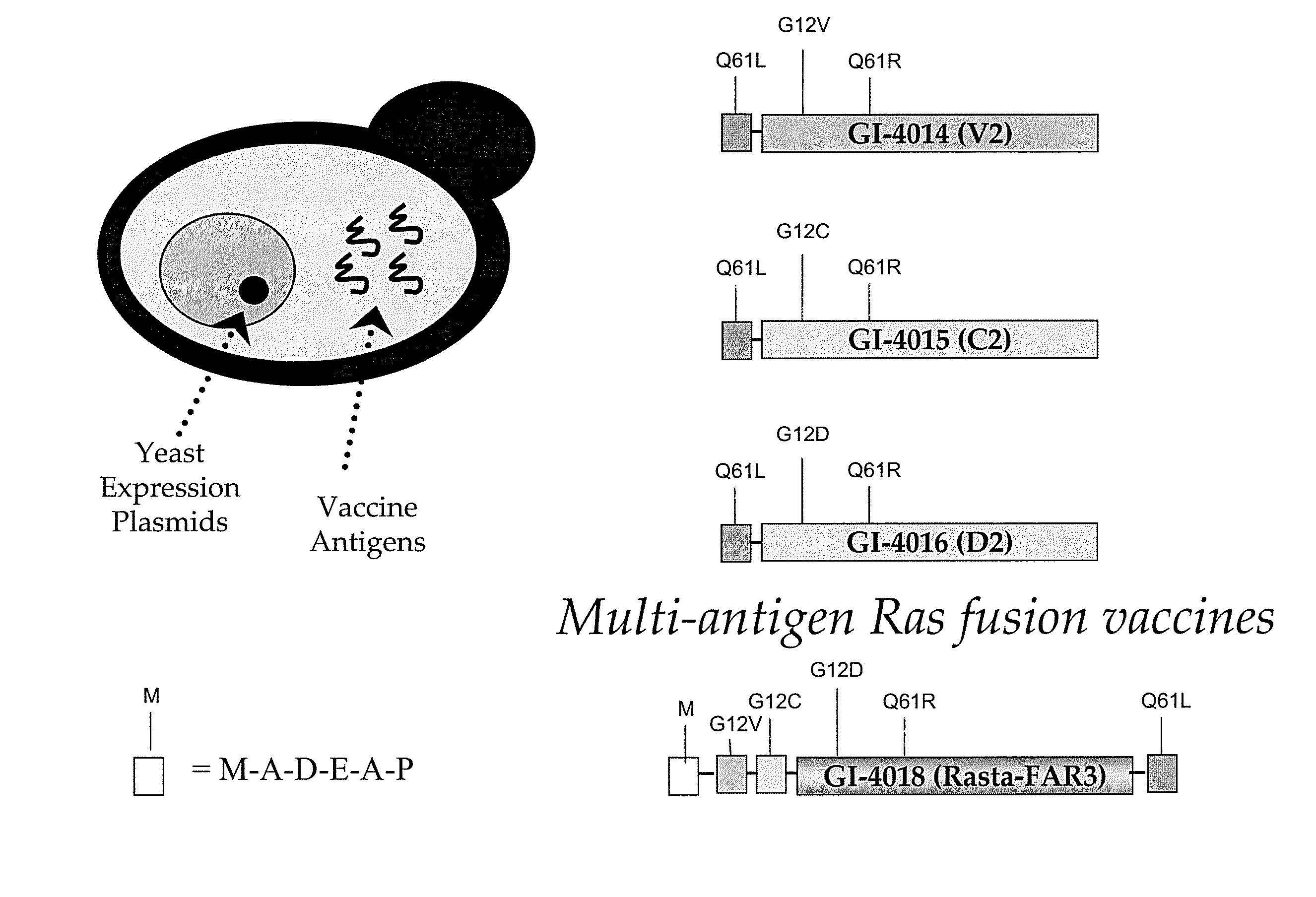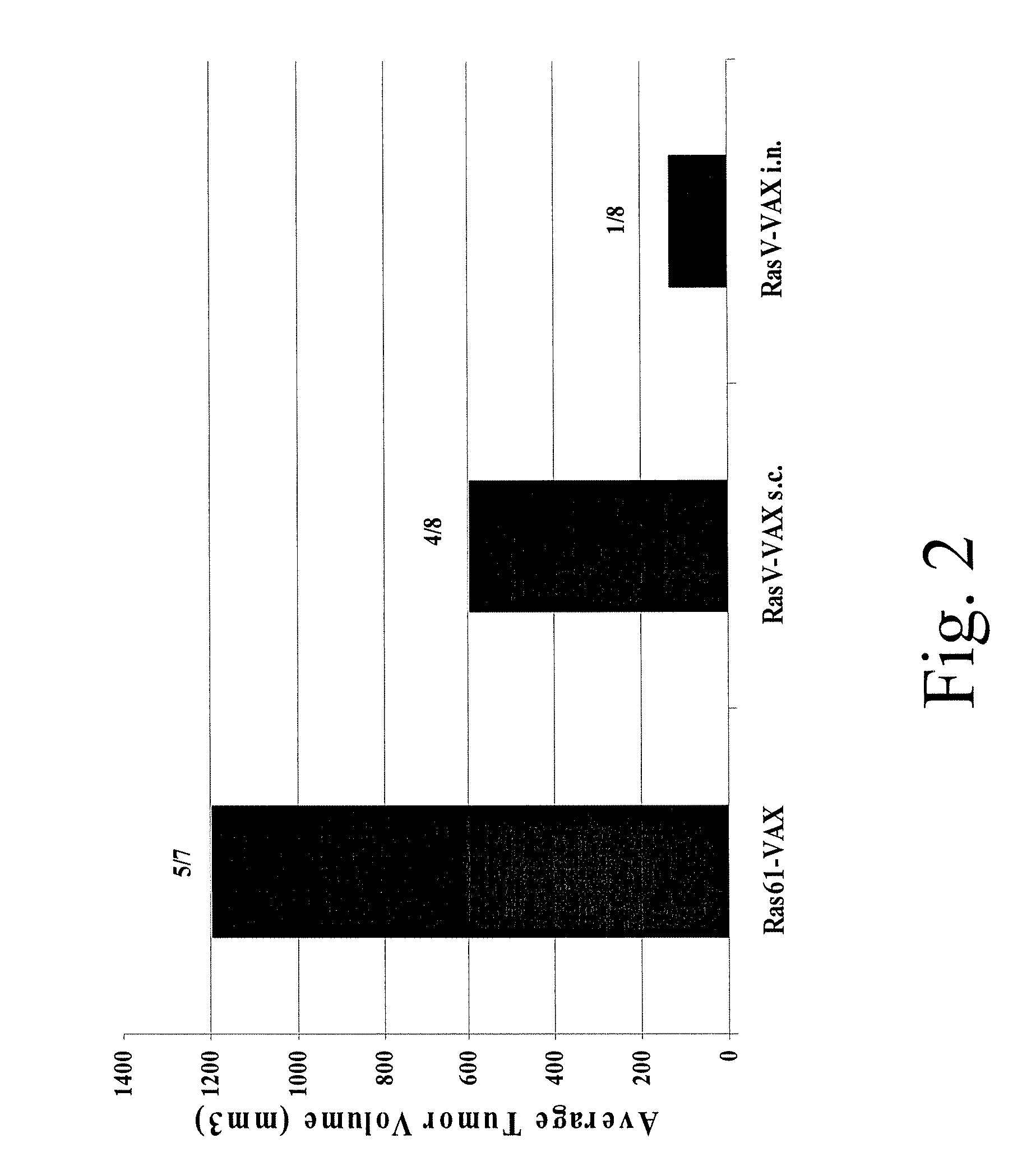Yeast-based vaccines as immunotherapy
a vaccine and yeast technology, applied in the field of yeast-based vaccines, can solve the problems of multiple drug therapy yielding minimal survival advantage with significant toxicities, difficult treatment or relatively unresponsive to standard chemotherapy, and many cancers that continue to have a high mortality rate, so as to prevent posttranslational modification, reduce or prevent at least one symptom of cancer in the animal.
- Summary
- Abstract
- Description
- Claims
- Application Information
AI Technical Summary
Benefits of technology
Problems solved by technology
Method used
Image
Examples
example 1
[0115] The following example demonstrates the administration of a yeast based vaccine comprising a cancer antigen for the treatment of a non-small cell lung carcinoma (NSCLC) in vivo.
[0116] Ras mutations are common in pulmonary adenocarcinomas of humans, mice, rats and hamsters. In fact, mutations in the ras proto-oncogene family are the most common oncogene-related mutations in human cancer and in tumors in experimental animals. The present inventors tested whether yeast-based vaccines which have now been designed to be directed to mutant protein-specific ras mutations, can induce productive immune responses that lead to tumor destruction in mouse lung adenocarcinoma models. The overall goal of the experiments was to establish that such a vaccine could be used to combat lung cancer in humans.
[0117] The model used in the experiments described herein is a mouse model in which A / J mice are injected with urethane (ethyl carbamate, which is metabolized to vinyl carbamate, the presumpt...
example 2
[0121] The following example demonstrates the use of a yeast-based vaccine comprising a cancer antigen to treat a brain tumor in vivo.
[0122] In the following experiment, groups of 5 mice were immunized twice (day 0 and day 7) with Gag protein-expressing vaccine (GI-VAX) or PBS (mock injected) by subcutaneous injection or intranasal administration, then challenged on day 14 with tumors expressing the Gag protein. The results from two independent studies revealed prolonged survival against intracranial tumor challenge in mice receiving the vaccine by intranasal administration, as compared to mock-injected mice, and surprisingly, as compared to animals receiving the vaccine by a subcutaneous route (FIG. 3). Subcutaneous immunization did protect animals against subcutaneous tumor challenge (data not shown). These results show that the method of the present invention can be used effectively when administered intranasally and that administration to the respiratory tract may be efficaciou...
example 3
[0123] The following example demonstrates the use of a yeast-based vaccine comprising a human cancer antigen (epidermal growth factor receptor; EGFR) to treat a melanoma and a brain tumor in vivo.
[0124] The ability of immunotherapeutic strategies to elicit protective immune responses is dependent on a number of important variables. First, the vaccine must be able to activate the immune system to recognize the target antigen, i.e. to provide “adjuvant” activity. In the case of the yeast-based vaccine, the inventors had previously shown that uptake of yeast into dendritic cells upregulated MHC class I and class II protein expression, and to trigger cytokine production, which are the hallmarks of adjuvant activity (Stubbs et al, Nature Med (2001) 7, 625-629). The degree to which yeast activate the ‘innate’ immune system was equivalent to that seen by using lipopolysaccharide (LPS) derived from bacterial cell walls. Second, the vaccine must promote surface presentation of the immunodom...
PUM
 Login to View More
Login to View More Abstract
Description
Claims
Application Information
 Login to View More
Login to View More - R&D
- Intellectual Property
- Life Sciences
- Materials
- Tech Scout
- Unparalleled Data Quality
- Higher Quality Content
- 60% Fewer Hallucinations
Browse by: Latest US Patents, China's latest patents, Technical Efficacy Thesaurus, Application Domain, Technology Topic, Popular Technical Reports.
© 2025 PatSnap. All rights reserved.Legal|Privacy policy|Modern Slavery Act Transparency Statement|Sitemap|About US| Contact US: help@patsnap.com



